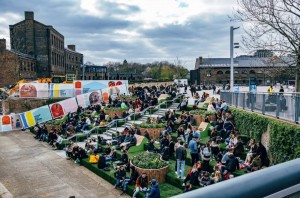Ray Oldenberg has one of the most interesting philosophies on how to create a functioning society. He believes in the power of “third places” and their ability to promote equality, engagement, and vitality. They are important for bringing people together and establishing bonds. We want to have a closer look at this here, as well as the challenges of creating these spaces today. Then, if you want help from a passionate architect in London, you can rely on us.
Three types of spaces
Oldenberg’s philosophy identifies three types of places. First places are our homes. They are essential, but are informal and isolating. On the other hand, second places are workplaces. They are typically more formal and tend to have a stricter structure for interactions. Third places are neutral public areas. They are distinct because they encourage free interaction without the formality of work.
A number of different spaces classify as third places. It can include public buildings like libraries as well as business spaces such as cafes, bars, and restaurants. Parks, plazas, marketplaces, and even main streets are all included. In fact, if it is a space where people can get together informally, it counts.
The problem
 Traditionally, there were many third places in every urban setting. However, over time, and with the growth of suburbanisation, a lot of them are gone. For example, recent research by the BBC says 190 libraries have been shut in the UK in the last five years. At the same time, thousands of pubs have called time since 2000.
Traditionally, there were many third places in every urban setting. However, over time, and with the growth of suburbanisation, a lot of them are gone. For example, recent research by the BBC says 190 libraries have been shut in the UK in the last five years. At the same time, thousands of pubs have called time since 2000.
As a top architect in London, we can see how modern building causes issues here. Housing developments can cause problems because of a lack of third places. Highways and roads can create barriers in communities. Even when open spaces are part of a design, sometimes they can be simple concessions instead of focusing on delivering spaces a community will use.
Modern living has also become increasingly isolated. For some it is even harder post-Covid because of remote and hybrid learning. Most people now do the majority of their interactions online. Even if they don’t, the use of third places is falling. Even when people do go to them, in many cases loitering isn’t tolerable. Commercialisation generally encourages rapid turnover in places like coffee shops.
What to do?
If we want to improve things, we need to revive public spaces and do more to support communities. It can actually be really beneficial for businesses too. We’d love to help design these spaces, giving clients input from the most creative architect in London.
A great idea is to ensure work, retail, and public buildings have more informal communal settings. They should be comfortable, and invite people to come together for as long as they wish. Housing developments should also have these kinds of spaces, including communal gardens. Hobby space is particularly fantastic because it invites people to interact over shared interests.
One thing to look at is different types of third spaces. What you need to focus on is the kind of interactions and how to best facilitate them. You need to design some for broad accessibility, ensuring there are no barriers at all. Others need to serve a niche, with a specific audience in mind. A combination of spaces in urban and suburban areas will help to strengthen the communities.
Do you want to work with a top architect in London?
Coffey Architects knows how important it is to design with people in mind. This is true whether you are creating homes, workplaces, or public space. People will always be happier and healthier when it is easy to connect and socialise. In a modern world where isolation is a serious issue, every project should look at ways to build stronger communities.
So, if you want some help from an exceptional architect in London, speak to us. You can have a look at our portfolio if you want to see some of the third spaces we design, including libraries, plazas, gardens, and more.
